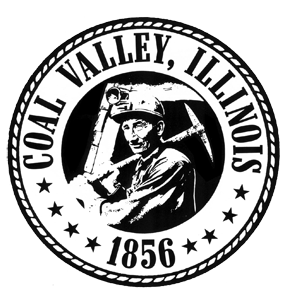 History
History
Past
The first settlers in Coal Valley were trappers and farmers who came from Wales, England, Ireland, Germany and Sweden. The pioneer settlers of the community are thought to have been William and Charles Bailey who built the first house within the present village limits. It is also believed that they operated a small mine, which could quite possibly be the first discovery of coal in the vicinity.
The Coal Valley Mining Company was formed in 1856. The men who incorporated the company were Holmes Hakes, Charles Buford, S.S. Guyer, Ben Harper and N.B. Buford. They gave the community its name. The booming years for coal mining in Coal Valley was from the 1850's to about the middle of the 1870's. Over the years other mining companies moved in. 1942 saw the end of coal mining in and around this community.
In March of 1876 a vote was taken and passed to form the Village of Coal Valley. On April 22, 1876 the first Board of Trustees was made. On April 22, 1876 H.B. Sudlow was chosen president and Harvey Clark was appointed the first Constable.
In May of 1892 following a petition signed by twenty-eight citizens of Coal Valley, asking that a town hall be erected. The lots needed for the building site were purchased from Gustave Krapp, Sr. Mr. Johnson of Orion was contracted to erect the building. The hall was built identically to Orion's town hall. Work began in September and by Thanksgiving the building was up. In January of 1893 the hall was officially accepted. The total cost was under $3,000.00.
In April of 1900 the Village Board purchased a fire engine and hose cart for the sum of $875.00. In November of 1900 the Village Board purchased the land and built a one-story fire station.
In 1929 the construction of Highway 150 was completed through the Village, and in 1933 it was extended as far East as Orion.
In 1939 the Coal Valley High School was built at the cost of $70,000 and that fall forty-six pupils were enrolled. The first mebers to graduate from the new Coal Valley High School were Ruth Schroeder, Evelyn Martin, Mary Kepple, Florence Robinson, Raymond Johnson, Harlan Raub, Robert Anderson, Sydney Bradford and Francis Creger. The Coal Valley High School was dissolved in 1952 and used as the junior high, and high school students attended the new high school in Moline.
Coal Valley has seen many ups and downs through the past, but has always remained a very close and quiet community where you would be proud to raise your children.
Present
The Village of Coal Valley is part of the Quad Cities (Rock Island and Moline Illinois, Bettendorf and Davenport, Iowa) metropolitan area located south of Moline. The Village is approximately 2.3 square miles with a population of approximately 3,800. Settled in 1856 when coal deposits were found in the area, Coal Valley was incorporated in 1876 and took its name from the Coal Valley Mining Company.
Residents of Coal Valley have advantages of small-town living, with the amenities of the Quad Cities metro area available nearby. The Quad City International Airport is adjacent to Coal Valley and is home to five major airlines offering daily flights to five central U.S. airport hub cities. Commuter flights to Chicago and other nearby cities are also available on a daily basis. The Quad Cities area is served by Interstate highways 74, 280, 80 & 88 and has four main bridges across the Mississippi River. U.S. Highways 6 and 150 pass within Coal Valley 's village and Interstates 74 and 280 are in close proximity to the village.
Conventional single family homes predominate in Coal Valley. Residential areas are scattered throughout the Village and comprise about 42% of the Village land area. Parks and recreational areas occupy approximately 18%, and agricultural/open land spaces account for 33% of Coal Valley's total land use.
The public school system in the Illinois Quad Cities has a reputation of quality and curriculum and academics. The Moline/Coal Valley School District has a total enrollment of more than 8,000 students and an average pupil-to-teacher ratio of 20.1 in elementary and middle schools and 19.1 in the high school. There are a number of opportunities for higher education in the area, including Augustana College, Rock Island, Illinois; Black Hawk College, Moline, Illinois; Western Illinois University Quad Cities Campus, Moline, Illinois; and St. Ambrose University, in Davenport, Iowa.
The Village of Coal Valley will continue to be primarily a residential community offering a positive living environment for people of all ages and backgrounds. The area of the Village will be expanded to include a greater range of housing types; to accommodate the needs of its residents and to provide space for additional commercial and light industrial development to diversify the tax base. Local public services and facilities will be developed and maintained at a level desired and needed by Village residents and its expanded commercial and light industrial activities.
The Village of Coal Valley is governed by a Village President, elected for a four-year term, and a six-member Board of Trustees, who are elected for a four-year, staggered term. The Village President is the chief executive officer of the Village and has supervision over all officers and employees of the Village. The Village President has the power to delegate to any officer any duty, which is to be performed that has not been specifically assigned. The Board of Trustees is the legislative department of the Village government and performs such duties and has such powers as delegated by statute.
The Village Administrator manages the day-to-day operations of the Village with the help of four full-time Department Heads (Police, Finance, Streets/Parks and Sewer/Water.